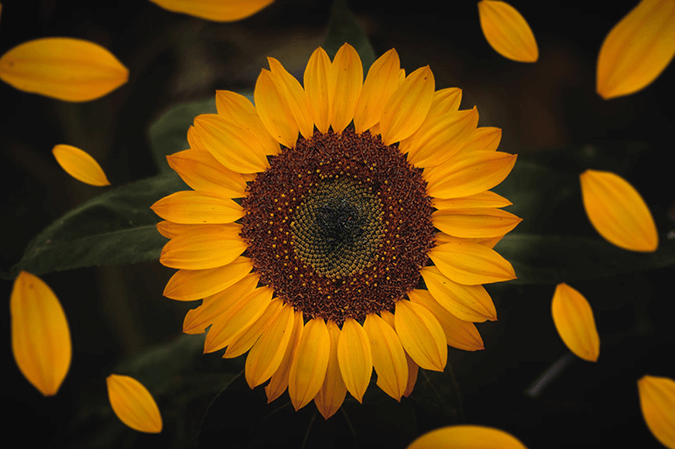Description
The sunflower (Helianthus annuus) is a large, bright yellow flowering plant that is native to North America. It belongs to the Asteraceae family, which includes daisies and asters. Sunflowers are known for their large, round flower heads, which can reach up to 30 centimeters in diameter, and their tall, sturdy stems that can grow up to 3 meters in height. The plant’s name is derived from its tendency to turn its flower head to follow the sun, a phenomenon known as heliotropism.
- Appearance: Sunflowers are easily recognizable by their vibrant yellow petals (ray florets) surrounding a central disk of smaller, darker flowers (disk florets). The central disk eventually matures into seeds.
- Height: Sunflowers can vary greatly in height, from 0.5 meters for dwarf varieties to over 3 meters for larger types.
- Leaves: The leaves are large, broad, and heart-shaped, with a rough texture.
Common Features
- Heliotropism: Young sunflower plants exhibit heliotropism, where they track the movement of the sun from east to west throughout the day. This trait diminishes as the flower matures.
- Seeds: Sunflowers produce a large number of seeds, which are used for food and oil production. The seeds are encased in a tough outer shell and are rich in nutrients.
- Varieties: There are many varieties of sunflowers, ranging from the common yellow types to those with red, orange, or even white petals.
Role in the Ecosystem
- Pollinator Attraction: Sunflowers are excellent at attracting pollinators such as bees, butterflies, and other insects. The large, open flower heads provide an abundant source of nectar and pollen.
- Bird Food: The seeds of the sunflower are a vital food source for birds, especially in late summer and autumn when other food sources may be scarce.
- Soil Remediation: Sunflowers have been used in phytoremediation efforts to extract toxins, such as heavy metals, from contaminated soils. Their extensive root systems help to stabilize soil and prevent erosion.
Importance
- Agriculture: Sunflowers are an important crop for both oil and seed production. Sunflower oil is widely used in cooking and as an ingredient in various products. The seeds are consumed as snacks or used as ingredients in a variety of foods.
- Cultural Significance: Sunflowers hold cultural significance in various societies. In Native American cultures, they were used as a source of food, dye, and oil. Sunflowers are also a symbol of adoration, loyalty, and longevity in different cultures.
- Economic Value: Sunflower farming is a significant agricultural industry in many countries. The plant is cultivated extensively for its seeds and oil, which have various culinary and industrial applications.
- Environmental Contribution: Sunflowers contribute to biodiversity by providing habitat and food for various species of insects, birds, and mammals.
Interesting Facts
- Phytoremediation: Sunflowers were used in the cleanup of the Chornobyl nuclear disaster site to help remove radioactive isotopes from the soil.
- Sunflower Oil: Sunflower oil is considered one of the healthiest vegetable oils, being rich in Vitamin E and low in saturated fats.
- Sunflower Fields: In addition to their agricultural value, sunflower fields are popular tourist attractions due to their stunning visual appeal.
Sources
- National Sunflower Association
- Royal Horticultural Society
- USDA Plants Database
- Missouri Botanical Garden



